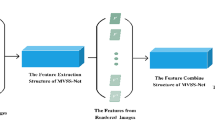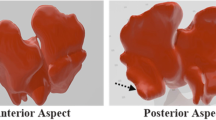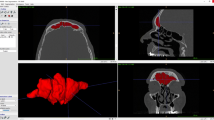Abstract
Recent clinical research studies in forensic identification have highlighted the interest in sphenoid sinus anatomical characterization. Their pneumatization, well known as extremely variable in degrees and directions, could contribute to the radiologic identification, especially if dental records, fingerPrints, or DNA samples are not available. In this paper, we present a new approach for automatic person identification based on sphenoid sinus features extracted from computed tomography (CT) images of the skull. First, we present a new approach for fully automatic 3D reconstruction of the sphenoid hemisinuses which combines the fuzzy c-means method and mathematical morphology operations to detect and segment the object of interest. Second, deep shape features are extracted from both hemisinuses using a dilated residual version of a stacked convolutional auto-encoder. The obtained binary segmentation masks are thus hierarchically mapped into a compact and low-dimensional space preserving their semantic similarity. We finally employ the ℓ2 distance to recognize the sphenoid sinus and therefore identify the person. This novel sphenoid sinus recognition method obtained 100% of identification accuracy when applied on a dataset composed of 85 CT scans stemming from 72 individuals.

Automatic Forensic Identification using 3D Sphenoid Sinus Segmentation and Deep Characterization from Dilated Residual Auto-Encoders











Similar content being viewed by others
References
Thery A, Espitalier F, Cassagnau E, Durand N, Malard O (2012) Clinical features and outcome of sphenoid sinus aspergillosis: a retrospective series of 15 cases. Eur Ann Otorhinolaryngol Head Neck Dis 129 (4):179–184
Stenner M, Rudack C (2014) Diseases of the nose and paranasal sinuses in child. GMS Curr Top Otorhinolaryngol- Head Neck Surg 13(10):1–27
Auffret M, Garetier M, Diallo I, Aho S, Ben Salem D (2016) Contribution of the computed tomography of the anatomical aspects of the sphenoid sinuses to forensic identification. J Neuroradiol 43(6):404–414
de Souza LA Jr, Marana AN, Weber SA (2018) Automatic frontal sinus recognition in computed tomography images for person identification. Forensic Sci Int 286(5):252–264
Deloire L, Diallo I, Cadieu R, Auffret M, Alavi Z, Ognard J, Ben Salem D (2019) Post-mortem X-ray computed tomography (PMCT) identification using ante-mortem CT-scan of the sphenoid sinus. J Neuroradiol 46(4):248–255
Güldnerc C, Pistorius S, Diogo I, Bien S, Sesterhenn A, Werner J (2012) Analysis of pneumatization and neurovascular structures of the sphenoid sinus using cone-beam tomography (cbt). Acta Radiol 53(2):214–9
Chaiyasate S, Baron I, Clement P (2007) Analysis of paranasal sinusdevelopment and anatomical variations: a ct genetic study intwins. Clin Otolaryngol 32(2):93–100
Oliveira J, Alonso M, de Sousa E Tucunduva M, Fuziy A, Scocate A, Costa A (2016) Volumetric study of sphenoid sinuses: anatomical analysis in helical computed tomography. Surg Radiol Anat 39(4):367–374
Dastidar P, Heinonen T, Numminen J, Rautiainen M, Laasonen E (1999) Semi-automatic segmentation of computed tomographic images in volumetric estimation of nasal airway. Eur Arch Otorhinolaryngol 256(4):192–198
Tingelhoff K, Moral AI, Kunkel ME, Rilk ME, Wagner I, Eichhorn KWG, Wahl FM, Bootz F (2007) Comparison between manual and semi-automatic. segmentation of nasal cavity and paranasal sinuses from ct images. In: 29th An. Int. Conf. IEEE EMBS
Huang Z, Zhang Y, Li Q, Zhang T, Sang N (2018) Spatially adaptive denoising for X-ray cardiovascular angiogram images. Biomed Signal Proc Control 40:131–139
Huang Z, Li Q, Fang H, Zhang T, Sang N (2017) Iterative weighted nuclear norm for X-ray cardiovascular angiogram image denoising. Signal Image Video Process 11:1445–1452
Last C, Winkelbach S, Wahl FM, Eichhorn KWG, Bootz F (2010) A model-based approach to the segmentation of nasal cavity and paranasal sinus boundaries. In: Goesele M, Roth S, Kuijper A, Schiele B, Schindler K (eds). Springer, Berlin, pp 333–342
Bui N, Ong S, Foong K (2015) Automatic segmentation of the nasal cavity and paranasal sinuses from cone-beam ct images. Int J Comput Assist Radiol Surg 10(8):1269–77
Sinha A, Leonard S, Reiter A, Ishii M, Taylor RH, Hager GD (2016) Automatic segmentation and statistical shape modeling of the paranasal sinuses to estimate natural variations. In: Proc. SPIE Int. Soc. Opt. Eng.
Haralick R, Shapiro L (1985) Image segmentation techniques. Comp Vision 29(1):100–132
Chan TF, Vese LA (2001) Active contours without edges. IEEE Trans Image Process 10(2):266–277
Kass M, Witkin A, Terzopoulos D (1988) Snakes: active contour models. Int J Comp Vision 4(1):321–331
Li C, Huang R, Ding Z, Gatenby JC, Metaxas DN, Gore C (2011) A level set method for image segmentation in the presence of intensity inomogeneneities whith application to mri. IEEE Trans Image Process 20 (7):2007–2016
Belaid A, Boukerroui D (2018) Local maximum likelihood segmentation of echocardiographic images with Rayleigh distribution. Signal Image Video Process 12(6):1087–1096
Zaouche R, Belaid A, Aloui S, Solaiman B, Lecornu L, Ben Salem D, Tliba S (2018) Semi-automatic method for low-grade gliomas segmentation in magnetic resonance imaging. IRBM 39(2):116–128
Bezdek J (1980) A convergence theorem for the fuzzy isodata clustering algorithms. IEEE Trans Pattern Anal Mach Intell 2
Xu C, Pham D, Prince J (1997) Finding the brain cortex using fuzzy segmentation, isosurfaces, and deformable surfaces. In: Proc. XVth Int Conf Inform Process Medical Imaging (IPMI 97), pp 399–404
Pham DL, Prince JL (1999) Adaptive fuzzy segmentation of magnetic resonance images. IEEE Trans Med Imaging 18:737–752
Ahmed M, Yamany S, Mohamed N, Farag A, Moriaty T (2002) A modified fuzzy c-means algorithm for bias field estimation and segmentation of mri data. IEEE Trans Med Imaging 21:193–199
Masci J, Meier U, Ciresan D, Schmidhuber J (2011) Stacked convolutional auto-encoders for hierarchical feature extraction. In: ICANN 2011. Springer, Berlin, pp 52–59
Vincent P, Larochelle H, Bengio Y, Manzagol P-A (2008) Extracting and composing robust features with denoising autoencoders. In: Proceedings of the 25th international conference on machine learning, ser. ICML ’08. ACM, New York, pp 1096–1103
He K, Zhang X, Ren S, Sun J (2016) Deep residual learning for image recognition. In: IEEE conference on computer vision and pattern recognition, CVPR, pp 770–778
Ioffe S, Szegedy C (2015) Batch normalization: accelerating deep network training by reducing internal covariate shift. ICML:448–456
Yu F, Koltun V, Funkhouser TA (2017) Dilated residual networks. In: IEEE conference on computer vision and pattern recognition, CVPR, pp 636–644
Yu F, Koltun V (2016) Multi-scale context aggregation by dilated convolutions. In: International conference on learning representations (ICLR)
Belaid A, Boukerroui D (2014) α scale spaces filters for phase based edge detection in ultrasound images. In: IEEE 11th international symposium on biomedical imaging (ISBI), pp 1247–1250
Author information
Authors and Affiliations
Corresponding author
Additional information
Publisher’s note
Springer Nature remains neutral with regard to jurisdictional claims in published maps and institutional affiliations.
Rights and permissions
About this article
Cite this article
Souadih, K., Belaid, A., Ben Salem, D. et al. Automatic forensic identification using 3D sphenoid sinus segmentation and deep characterization. Med Biol Eng Comput 58, 291–306 (2020). https://doi.org/10.1007/s11517-019-02050-6
Received:
Accepted:
Published:
Issue Date:
DOI: https://doi.org/10.1007/s11517-019-02050-6




